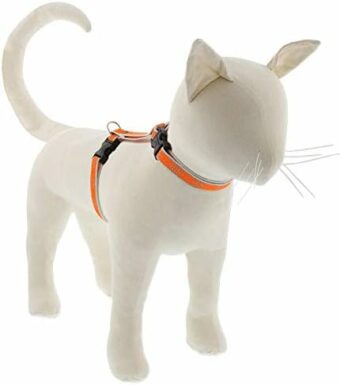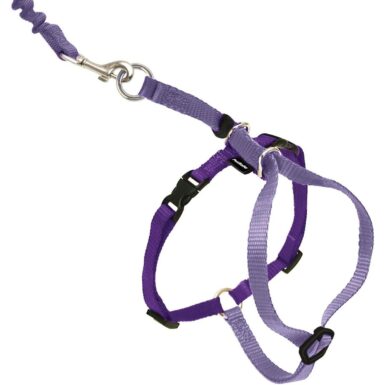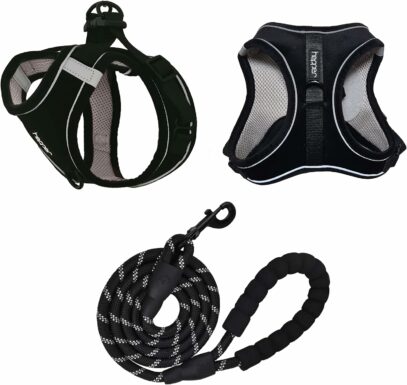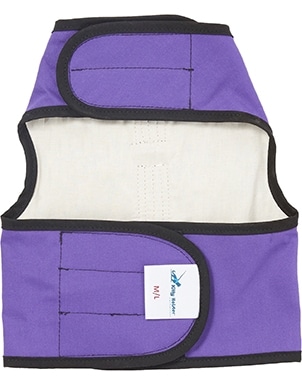Although cats are not known as leash walkers, many can learn to wear a harness and explore the outdoors. Walking with your cat is a great form of exercise, and it can reduce boredom for particularly active and curious cats.
Just as dogs wear different types of harnesses, you can find several different styles of harnesses for cats. Each type of harness has its own set of advantages and disadvantages. We’ll review each to help you decide which type of cat harness is best for your cat.


How Are Cat Harnesses Classified?
Cat harnesses are generally classified into four different types:
- H-style
- Y-style
- Vest-style
- Jacket style
You can also easily recognize them because they have unique forms. Each style has specific features and functions that suit different types of cats. In general, H-style and Y-style harnesses are the most common types of harnesses, and they are ideal for leisure walks and explorations. Vest-style and jacket-style harnesses are sturdier and often better suited for more active and athletic cats.
The 4 Types of Cat Harnesses
1. H-Style

| Material: | Nylon, leather |
| Best for: | Meek cats, cats that don’t want to be restricted |
The H-style harness is the most common type of harness. It got its name because its frame looks like an “H.” It usually has two loops. One loop goes over the cat’s head and rests around their neck, while the other loop wraps around the chest.
H-style harnesses are less restrictive than other types of harnesses. So, they are usually popular for cats starting to wear harnesses. However, smaller and thinner cats can easily escape from them. So, it is important to buy the right size.
2. Y-Style

| Material: | Nylon, leather |
| Best for: | Meek cats, cats that don’t want to be restricted |
Y-style harnesses are also called minimalist harnesses. These look like H-style harnesses, but they don’t wrap around your cat’s neck. The leash connects to a loop located at the base of the shoulders, so it’s often more comfortable for cats that tend to pull or jump.
Similar to H-style harnesses, Y-style harnesses work well with cats that prefer less restriction. However, this is a harness that even agile cats can easily escape from.
3. Vest Style

| Material: | Nylon, mesh |
| Best for: | Active cats, escape artists |
The vest-style harness has a more secure fit and is best suited for athletic cats and escape artists. They are also generally more comfortable for cats to wear and less likely to cause chafing than H-style and Y-style harnesses.
Because vest-style harnesses have a wider range, some cats may feel restricted in them at first. So, it’s often best to get your cat used to wearing an H-style or Y-style harness before introducing your cat to a vest-style harness.
4. Jacket Style

| Material: | Nylon, mesh, various materials |
| Best for: | Cats that live in colder climates |
Jacket-style harnesses offer the most coverage, and are useful if you live in an area with colder winters. If you don’t live in a colder climate, it’s usually not necessary to use a jacket-style harness, as vest-style harnesses are usually sufficient.
Jacket-style harnesses can feel the most restrictive for cats, so most cats who don’t normally enjoy wearing clothes won’t like wearing a jacket-style harness either. However, they do a great job of keeping your cat warm while they play outside during the colder months.
How to Measure Your Cat for a Harness
Getting your cat properly sized will greatly reduce the risk of injury and escape from a harness. The measurement that should be accurately measured is your cat’s chest.
Wrap the tape measure around the widest part of your cat’s chest. If you have a long-haired cat, make sure the tape measure is wrapped around the chest and close to the skin.
Once you measure your cat’s chest, you can start shopping for harnesses. Most harnesses are adjustable, so look for a harness with a maximum and minimum adjustable size that is just above and below your cat’s chest measurement. This will ensure that you can change the size of the harness to fit your cat.

Conclusion
Cats can explore the great outdoors by wearing different harnesses. H-style and Y-style harnesses have minimalist designs that work well with more docile cats and cats that don’t like the feeling of wearing clothes. Vest-style harnesses are better for active cats because they provide a more secure fit and reduce chafing. If you live in a colder climate, look into getting a jacket-style harness for your cat so they can still play outside when it starts to get cold.
Featured Image Credit: goldeneden, Shutterstock


